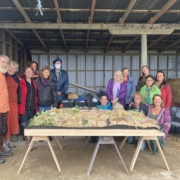The latest Community Workshop on Biodynamics was held on Saturday 12th February at the Steiner School site in Robinson Road, Lower Moutere. This was the third workshop in a series of eight which started in November last year. The Motueka Rudolf Steiner School Trust (MRSST) has been able to offer workshops in the theory and practice of using biodynamics to bring life and health back to our soils, our land and the food we grow, for koha. This has been through funding from Kete Ora Trust.
On Saturday, participants were led by Dieter Proebst with a morning theory session at the Steiner school which Dieter describes as ‘a mind massage’, and an afternoon session in the shed at the school’s farm. The workshop was entitled ‘Permaculture as a Design Framework for Biodynamics’, looking at the best of both and combining them. In the afternoon, participants were invited to create together a model landscape on a two square metre sandbox set up on a table. It was participatory and collaborative with lots of conversation.
Dieter is one of the founders of the Motueka Rudolf Steiner School Trust, which began in 1984 with the kindergarten in a house at Riverside, Lower Moutere. Dieter is a highly-experienced forester, nurseryman, farmer, and orchardist. He came to New Zealand from Germany in 1981 with a Master of Science/Forestry from Munich University, and he settled in the Motueka Valley on the West Bank.
Over 35 years, he turned 30 acres of bare pasture into a successful certified organic farm and nursery with, amongst others, over 100 varieties of apples. Dieter holds a Diploma in Permaculture Design and is a recognised land-use consultant. He has led many workshops over the years, is an author, a long-standing biodynamic grower and advisor, and a former Demeter Inspector.
There are many techniques of land management – biodynamics, permaculture, organics, regenerative agriculture and others. Dieter refers to these as ‘franchises’, as he believes the most important in all of these is the land, the environment, and working out what the land wants and needs: ”While there is a plethora of literature about land management,” Dieter says, “often the problem lies in people’s minds. People need to trust their instincts.”
His Treedimensions Land Use Consultancy, which he continues to run from where he now lives in Golden Bay, is about finding site appropriate solutions. He hopes that the workshop participants will learn to apply their own common sense, their gut feeling and their intuition to living with their land. He calls for people to have open minds, be curious and humble to learn.
The next Biodynamic Community workshop will be held on 266h March and will be led by Su Hoskin, an experienced biodynamic practitioner and educator, on making the Biodynamic preparations. Dieter will return for another workshop in April which will be about edible landscaping and the food forest concept. For more information and to reserve a place email carolynhughes@foulis.nz .The workshops are each limited to 25 people so registrations are on a first come first serve basis.
![]()
![]() What a great opportunity to spotlight high quality biodynamic food…!!
What a great opportunity to spotlight high quality biodynamic food…!! ![]()










